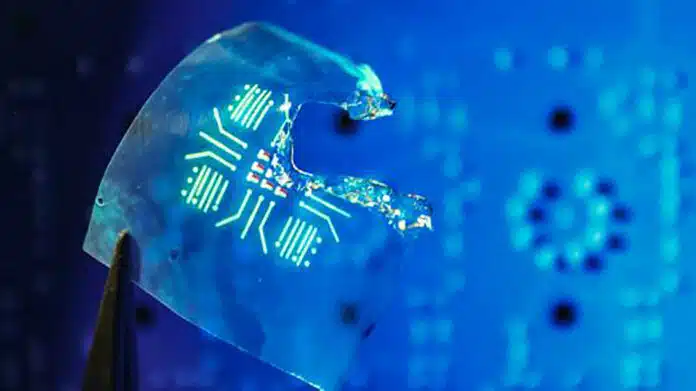
By Amit Malewar 23 Jul, 2024
Collected at: https://www.techexplorist.com/reducing-electronic-waste-biodegradable-luminescent-polymers/86394/
Luminescent polymers, with their impressive light-emitting capability, flexibility, and stretchability, are extensively utilized in today’s electronics, from car navigation displays to the device you are using to read this.
Yet, disposing of these electronics leads to environmental concerns, as they end up in landfills or underground burial. Recycling this electronic waste is challenging and involves costly, energy-inefficient processes.
While there is an economic drive to recycle key components such as luminescent polymers, the lack of efficient recycling methods poses a considerable challenge, mainly due to the challenge of designing those materials at the molecular level.
“We were able to make this material biodegradable and recyclable without sacrificing the functionality,” said Jie Xu, Argonne scientist who led the project
The most recent publication in Nature Sustainability, led by researchers at the U.S. Department of Energy’s Argonne National Laboratory, in collaboration with the University of Chicago, Purdue University, and Yale University, aims to address this challenge. From the beginning, the team has pioneered a strategy for designing luminescent polymers with high light-emitting efficiencies that are both biodegradable and recyclable.
They achieved this by integrating a chemical called tert-butyl ester into the luminescent polymers, which can disintegrate when exposed to heat or mild acid. In essence, this chemical breakthrough allows for the recycling of the material while preserving its high light-emitting functions.
The team utilized a device to assess the material’s external quantum efficiency, a key indicator of light source performance. Remarkably, it achieved a 15.1% score in electroluminescence, marking a tenfold increase from the current degradable luminescent polymers.
Upon reaching the end of its lifespan, this innovative polymer can undergo degradation under mild acidic conditions (similar to the pH of stomach acid) or relatively low heat treatment (> 410 F). The resultant materials can be extracted and repurposed into new materials for future applications.
“We were able to make this material biodegradable and recyclable without sacrificing the functionality,” said project lead Jie Xu, a scientist in the Center for Nanoscale Materials, a DOE Office of Science user facility at Argonne. “This work serves as an important benchmark in addressing the urgent need for sustainability in the design of future electronics.”
The team’s objective is to enhance the sustainability of future electronics by focusing on making them easier to degrade or recycle rather than solely designing for current functionality. They also aim to broaden the applications of these products beyond their current scope.
“Design is still compatible with processibility, and in the end, you have to use this in real applications,” said Yuepeng Zhang, a materials scientist at Argonne and a co-author of the publication. The researchers predict this new polymer can be applied to existing technologies, such as displays and medical imaging, and enable new applications.
To scale the technology, the next phase involves transitioning from lab settings to incorporating it into electronic devices, such as cell phones and computer screens while conducting ongoing testing.
The team emphasized that this is just the initial phase of the process but emphasized the significance of each step in addressing electronic waste. Xu expressed hope that there will be greater emphasis on designing electronics with recyclability in mind, particularly considering the promising success of the depolymerization proof of concept.
“This is a $46 billion-a-year industry, and it is only growing,” said Xu. “By 2032, the industry is estimated to grow to $260 billion. With this method, we can eliminate this type of electronic waste that would otherwise be piling up in landfills.”
Journal reference:
- Wei Liu, Yukun Wu, Aikaterini Vriza, Cheng Zhang, Hyocheol Jung, Shiyu Hu, Yuepeng Zhang, Du Chen, Peijun Guo, Benjamin T. Diroll, Glingna Wang, Richard D. Schaller, Henry Chan, Jianguo Mei, Sihong Wang & Jie Xu. Depolymerizable and recyclable luminescent polymers with high light-emitting efficiencies. Nature Sustainability, 2024; DOI: 10.1038/s41893-024-01373-z

Leave a Reply